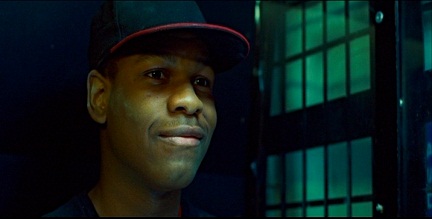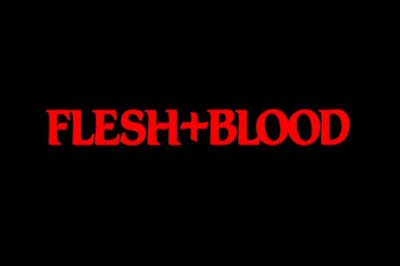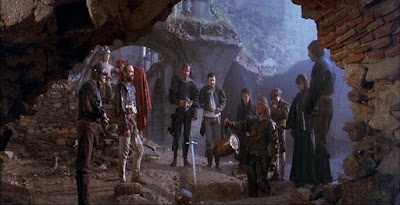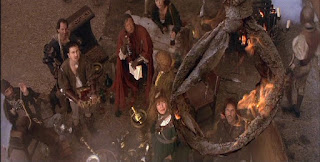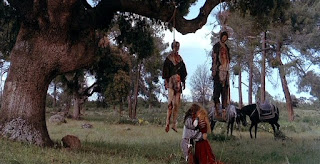Director: John Landis
Screenplay by: John Landis
Starring: David Naughton, Griffin Dunne, Jenny Agutter, John Woodvine, Brian Glover
Running Time: 97 minutes
Tagline: "From the director of ANIMAL HOUSE...a different kind of animal."
"Beware the moon, David."
 AN AMERICAN WEREWOLF IN LONDON came to Landis in a moment
that sounds like it could have been the opening of a werewolf movie itself. It
was 1969 and he was working as a production assistant on KELLY’S HEROES in
AN AMERICAN WEREWOLF IN LONDON came to Landis in a moment
that sounds like it could have been the opening of a werewolf movie itself. It
was 1969 and he was working as a production assistant on KELLY’S HEROES in  Two American college students, David Kessler (David Naughton) and Jack Goodman (Griffin Dunne), are backpacking across north England when they come across the sleepy village of East Proctor on a stormy night. The place makes a rather ominous first impression; what could charitably be called the center of town is dominated by an Angel of Death statue and the local pub carries the rather uninviting name of The Slaughtered Lamb, its sign depicting a severed wolf's head impaled on a pike. ("Where's the lamb?") But the boys are cold, hungry, and could use a rest, so despite their misgivings, they head inside. Once there, they run into the expected throng of suspicious-of-strangers types you find populating sleepy English villages in this sort of movie, and when Jack inquires to the purpose of a five pointed star on the wall,"The sign of the wolf man" according to him, they're asked none politely to move on. Their departure sparks an argument among the bar patrons, with some saying that they've just committed murder by sending the boys out on this particular night before the village leader (Brian Glover) shuts them all down with the usual "outsiders shouldn't be stickin' their nose into our business" spiel. Besides, they reason, the boys will be alright as long as they obey the cryptic warning to stay on the road, steer clear of the moors, right? Maybe nothing will happen...
Two American college students, David Kessler (David Naughton) and Jack Goodman (Griffin Dunne), are backpacking across north England when they come across the sleepy village of East Proctor on a stormy night. The place makes a rather ominous first impression; what could charitably be called the center of town is dominated by an Angel of Death statue and the local pub carries the rather uninviting name of The Slaughtered Lamb, its sign depicting a severed wolf's head impaled on a pike. ("Where's the lamb?") But the boys are cold, hungry, and could use a rest, so despite their misgivings, they head inside. Once there, they run into the expected throng of suspicious-of-strangers types you find populating sleepy English villages in this sort of movie, and when Jack inquires to the purpose of a five pointed star on the wall,"The sign of the wolf man" according to him, they're asked none politely to move on. Their departure sparks an argument among the bar patrons, with some saying that they've just committed murder by sending the boys out on this particular night before the village leader (Brian Glover) shuts them all down with the usual "outsiders shouldn't be stickin' their nose into our business" spiel. Besides, they reason, the boys will be alright as long as they obey the cryptic warning to stay on the road, steer clear of the moors, right? Maybe nothing will happen...Almost as if it that was its cue, something that sure as hell isn't a dog cuts loose with a very unpleasant sounding howl. The creature, a hulking beast that looks like a shaggy bear with canine features, chases the boys down, tackles Jack and rips him to pieces before David can come to help, and all that little act of bravery earns him is some teeth in his shoulder. The villagers, finally deciding they don't want the boys' blood on their hands, intervene and shoot the creature dead. Before David loses consciousness, he catches a glimpse of their attacker, which, strangely enough, is now a naked man.

David comes to in the hospital and discovers that weeks have passed. Jack's body has already been shipped back home and buried. Confusing David even further is when officials question him about the attack and he discovers that several witnesses blame it on an escaped lunatic. David's claims that his friend was killed by a monster are dismissed as the ravings of someone who's just been through a very traumatic event. That would be all she wrote, but David's having these dreams, you see: real vivid ones. Ones where monsters are killing his family or he's going through some form of transformation. Then there's the visit from his good buddy, the dearly departed Jack Goodman, Jack, who now looks like he's been thrown face first into a threshing machine, informs David that they were attacked by a werewolf. Seeing as David survived the werewolf's attack, the creature's curse has passed onto him and as long as the bloodline of the werewolf lives, Jack is condemned to walk the earth as a ghost, unable to pass on. As much as for wanting to save his friend from the cruel fate in store as he is wanting to be free from his own horrible unlife, Jack urges David to kill himself before the full moon rises.
If there's one bright spot for David in this whole mess, it's the Florence Nightingale-esque romance he's struck up with Alex (Jenny Agutter), the nurse who has been serving as his primary caregiver during his recovery. It's a testament to the actors and the filmmakers that they're able to sell us on this relationship despite it developing so fast, so we don't bat an eye, much, when he goes home with her once he's discharged. (And hey, it's Jenny Agutter.) The two sleep together that night but David's good mood doesn't last, because Jack makes a return appearance looking much worse for wear, and again warns him of what's coming. Up until now, David's been able to convince himself that everything; the monster, the dreams, Jack's ghost; was all in his head but he's beginning to question that. He won't have to wait long to get a definitive answer. The full moon is tomorrow night.
If you’re going to discuss AN AMERICAN WEREWOLF at any
length, you’re almost required to discuss that other werewolf movie that opened in 1981 and also featured a
totally boss transformation sequence, Joe Dante’s THE HOWLING. They’re practically
joined at the hip at this point. I had even planned on reviewing both movies in
one go for this blog entry, only to find my copy of THE HOWLING had
deteriorated to the point of being unplayable. Despite the close proximity of
their release dates, the two movies are pretty dramatically
different. LONDON
 Both were noted for their pitch-black humor, but THE HOWLING approached that through inside jokes and satirical touches, while AMERICAN WEREWOLF goes broader and more absurd, it's success laying in knowing exactly how to utilize that mixture of comedy and horror that so confused studios and later critics; when to contrast imagery and tone and when one needs to intrude on the other. Think of David's dream where he sees his family butchered by shrieking, monster headed Nazis while The Muppet Show plays in the background. The image is so over-the-top and bizarre that it's certainly amusing, like escapees from a creature feature crashed into some Family Ties-style sitcom, while at the same time...Holy Shit, right? Or the scenes late in the film where he sits in a theater with a particularly naff porno playing, surrounded by the bloody shades of his victims, all of whom are suggesting any number of methods he can use to kill himself in chipper tones of voice. It also helps that WEREWOLF knows when to pull back and let one aspect take over completely. The moments that are just straight comedy, like David having to escape from the zoo after waking up naked in the wolf's enclosure are legitimately hilarious. ("A naked American man stole my balloons!") Then, scenes that focus entirely on horror, such as the initial attack on David and Jack or a transformed David stalking his victims, still effectively generate a palpable amount of tension even after any number of repeat viewings. (I watch this flick at least once a year around this time, for obvious reasons.) The distance between terror and laughter isn't as far as many people think, and the best horror comedies like this or RETURN OF THE LIVING DEAD, know how to use one to underline the other. It doesn't hurt either that AN AMERICAN WEREWOLF may be the most quotable skinwalker flick, some of its best lines coming from the banter between David and Jack's ghost. ("Have you ever talked with a corpse? It's boring!" "I will not be threatened by a walking meatloaf!" "He is your good friend, whereas I am a victim of your carnivorous lunar activities!")
Both were noted for their pitch-black humor, but THE HOWLING approached that through inside jokes and satirical touches, while AMERICAN WEREWOLF goes broader and more absurd, it's success laying in knowing exactly how to utilize that mixture of comedy and horror that so confused studios and later critics; when to contrast imagery and tone and when one needs to intrude on the other. Think of David's dream where he sees his family butchered by shrieking, monster headed Nazis while The Muppet Show plays in the background. The image is so over-the-top and bizarre that it's certainly amusing, like escapees from a creature feature crashed into some Family Ties-style sitcom, while at the same time...Holy Shit, right? Or the scenes late in the film where he sits in a theater with a particularly naff porno playing, surrounded by the bloody shades of his victims, all of whom are suggesting any number of methods he can use to kill himself in chipper tones of voice. It also helps that WEREWOLF knows when to pull back and let one aspect take over completely. The moments that are just straight comedy, like David having to escape from the zoo after waking up naked in the wolf's enclosure are legitimately hilarious. ("A naked American man stole my balloons!") Then, scenes that focus entirely on horror, such as the initial attack on David and Jack or a transformed David stalking his victims, still effectively generate a palpable amount of tension even after any number of repeat viewings. (I watch this flick at least once a year around this time, for obvious reasons.) The distance between terror and laughter isn't as far as many people think, and the best horror comedies like this or RETURN OF THE LIVING DEAD, know how to use one to underline the other. It doesn't hurt either that AN AMERICAN WEREWOLF may be the most quotable skinwalker flick, some of its best lines coming from the banter between David and Jack's ghost. ("Have you ever talked with a corpse? It's boring!" "I will not be threatened by a walking meatloaf!" "He is your good friend, whereas I am a victim of your carnivorous lunar activities!") If there's one thing that both AN AMERICAN WEREWOLF and THE HOWLING have in common it's the major shifts they represented in the werewolf genre. The biggest one being that, after these two movies, just dissolving between shots of an actor with more hair glued to his face wasn't going to cut it for a transformation anymore. Special effects technology had finally reached a point where you could show the hair grow, claws sprout, the limbs and face distort, selling you on the idea that yeah, changing into a completely different species was horrifying and painful to watch. Horror fans will debate 'til kingdom come which movie had the better wolf-out scene but neither are anything to sneeze at. Coincidently enough, Rick Baker was attached to do the effects work for THE HOWLING but decided to jump to WEREWOLF due to his earlier commitment to Landis, handing Dante's movie off to his protégé, Rob Bottin. I'd say things worked out for both. THE HOWLING made Bottin's career and opened the door for projects like THE THING, ROBOCOP, and TOTAL RECALL and Baker received the first Academy Award for Make-Up Effects thanks to WEREWOLF. (Presented by Vincent Price!) Thirty odd years later, they still impress, WEREWOLF's even more so because it makes no effort hide it through dim lighting or excessive editing. Landis had complete confidence in Baker's skill and lets the audience linger on every detail.
If there's one thing that both AN AMERICAN WEREWOLF and THE HOWLING have in common it's the major shifts they represented in the werewolf genre. The biggest one being that, after these two movies, just dissolving between shots of an actor with more hair glued to his face wasn't going to cut it for a transformation anymore. Special effects technology had finally reached a point where you could show the hair grow, claws sprout, the limbs and face distort, selling you on the idea that yeah, changing into a completely different species was horrifying and painful to watch. Horror fans will debate 'til kingdom come which movie had the better wolf-out scene but neither are anything to sneeze at. Coincidently enough, Rick Baker was attached to do the effects work for THE HOWLING but decided to jump to WEREWOLF due to his earlier commitment to Landis, handing Dante's movie off to his protégé, Rob Bottin. I'd say things worked out for both. THE HOWLING made Bottin's career and opened the door for projects like THE THING, ROBOCOP, and TOTAL RECALL and Baker received the first Academy Award for Make-Up Effects thanks to WEREWOLF. (Presented by Vincent Price!) Thirty odd years later, they still impress, WEREWOLF's even more so because it makes no effort hide it through dim lighting or excessive editing. Landis had complete confidence in Baker's skill and lets the audience linger on every detail.
There’s one more thing I’d like to
discuss about AN AMERICAN WEREWOLF before I close out this post,
something that stuck out at me when I re-watched it for this review.
Now, we’re all familiar with the various spiels about what fears
your classic monsters represent, right? The vampire is unrestrained
sexuality, zombies are the inevitability of death and societal decay
through conformity, etc. etc. Our good friend the wolf man? Loss of
control. Giving in to your subconscious primal impulses. The Old
Adam, as Stephen King calls it in his treatise on the horror genre,
DANSE MACABRE, which is a phrase that I love and so badly want to use
as a title for a horror story that I’ll probably never write. The
beast beneath the skin is the go to supernatural archetype for
stories about someone’s bad side coming out to play and has been
used as such for everything from abusive relationships (an episode of
BUFFY THE VAMPIRE SLAYER) to young girls going through puberty.
(GINGER SNAPS) What I find interesting though, is how rarely
lycanthropy is used in fiction and film in connection with mental
instability, especially when so many stories of it from history and
folklore come across sounding a lot like a person suffering from
that. Just ask Nebuchadnezzar. THE WOLF MAN touches on it a bit, but
in the end, that’s simply Larry Talbot desperately trying to find a
rational explanation for what is happening to him. THE WOLF MAN is
too straightforward a movie for the connection between the two to
take. THE HOWLING definitely plays around with it, what with its
setting being a mental health care retreat that its beasties use as
way to hide in plain sight while learning to keep their animal side
under control. Werewolf rehab, if you will. But in the end, its focus
remains primarily on the tried and true angle of werewolf as the
monster from the id. (No, not that one.) Discussing this with some of
my fellow movie buffs, the only movie that uses werewolves explicitly
as a metaphor for mental illness we could name was one of the GINGER
SNAPS sequels. In that, it’s basically a medical condition and if
the main character doesn’t get the medicinal herbs she needs to
keep it in line, she starts self-harming and doing other things that
you often see in cases of people who need treatment for depression.
What does this have to do with AN
AMERICAN WEREWOLF? Well, look at what David experiences through the
whole movie. He suffers from nightmares and hallucinations so
frequently he begins to wonder what is real and what isn’t. He
struggles with suicidal impulses. When he transforms into his wolf
form, he blacks out and has no memory of anything that he does. Alex
and David’s doctor certainly don’t buy into any of this talk of
werewolves but they certainly believe that David is in a state where
he could be a harm to himself or others. And consider that what
starts this is seeing a close friend get killed horribly before he
himself is badly injured and put into a coma. I don’t know about
you guys but I’ll be damned if this doesn’t read like some of the
more extreme cases of Post-Traumatic Stress Disorder. AN AMERICAN
WEREWOLF does a fantastic job of making you experience its main
character’s disassociation with reality, with only its repeated
cuts to the perspective of other characters preventing it from being
on par with say, MIRACLE MILE, in that regard. What’s surprising
about this and a good indicator of how sometimes the end result can
get away from a creator’s intentions is that I don’t think that
was exactly what Landis and company were going for. The reoccurring
instance of David waking up from dream after dream until you’re
left unsure whether what he’s seeing is real or not, Landis admits,
was something he lifted from a Bunuel film that achieved a similar
effect through that motif. You also have to account for how much AN
AMERICAN WEREWOLF draws from THE WOLF MAN, so of course, it would
feature characters blaming what’s happening as the result of the
protagonists fractured mind. Then there’s the fact that in
interviews with Landis and Naughton, they show that while they did
think of David’s condition in terms of a disease, it was a physical
sickness, not mental, they approached it as, playing him as someone
who refused to face that he has a terminal disease. So, as it turns
out, the most effective “werewolf-as-mental-problem-stand-in”
story may have been the result of an entirely coincidental
combination of influences and shooting close to the mark, with what
we understand about the werewolf represents filling in the blanks as necessary.
This review was part of the Celluloid Zeroes ADULT ONSET LYCANTHROPY ROUNDTABLE. Want more? Head over to Checkpoint Telstar for Tim's review of THE BAT PEOPLE, or maybe stop by The Terrible Claw Reviews for Gavin's opinion on SSSSSSS. Still not enough? Cinemasochistic Apocalypse bites into the samurai werewolf flick (!!) KIBAKICHI, 3-Beer Theater is inflicted with THE CURSE OF THE BLACK WIDOW, The Tomb of Anubis takes on ROMASANTA, Las Peliculas de Terror deals with a were-cicada infestation with THE BEAST WITHIN, and Web of the Big Damn Spider goes back to SUMMER SCHOOL.





